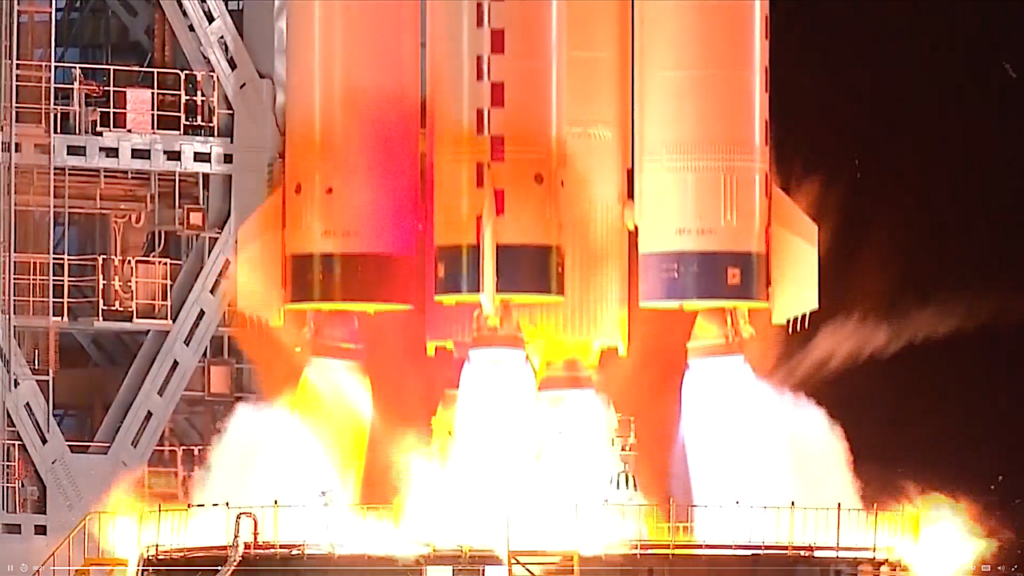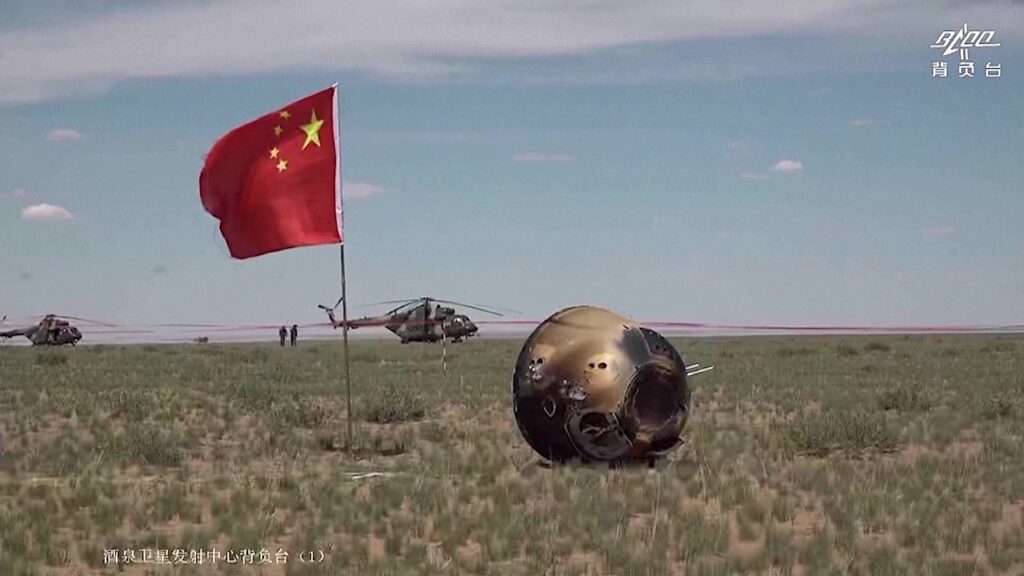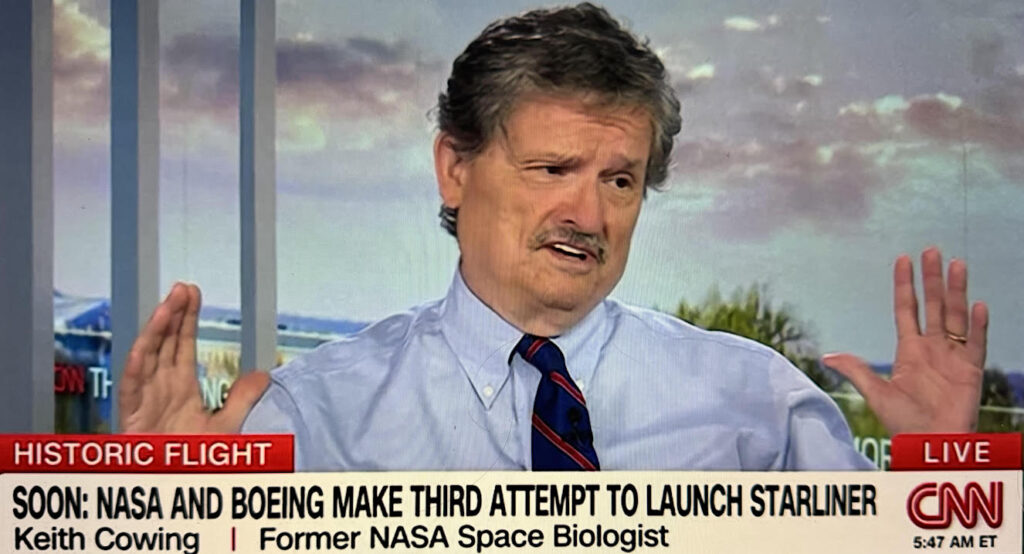China Reminds Washington About Their Space Program

 Keith’s note: Every month or so I open my morning copy of the Washington Post to be greeted by a 8 page, full color insert – called “China Watch” 😉 – that China Daily pays to shove inside my paper – the same one that everyone in DC reads (larger image). Today’s insert had an above-the-fold headline story titled “Astronauts Prepare For a New Era of Exploration”. This certainly sounds like a headline that this White House would issue, right? But its not. China’s state media editors who write the text for these things do not mince words when it comes to what they see lying ahead: “If the United States-led International Space Station is retired as planned in 2024, the new, yet unnamed, Chinese facility will become the only permanent space station.”
Keith’s note: Every month or so I open my morning copy of the Washington Post to be greeted by a 8 page, full color insert – called “China Watch” 😉 – that China Daily pays to shove inside my paper – the same one that everyone in DC reads (larger image). Today’s insert had an above-the-fold headline story titled “Astronauts Prepare For a New Era of Exploration”. This certainly sounds like a headline that this White House would issue, right? But its not. China’s state media editors who write the text for these things do not mince words when it comes to what they see lying ahead: “If the United States-led International Space Station is retired as planned in 2024, the new, yet unnamed, Chinese facility will become the only permanent space station.”









Go, China!!
So what? The US lost its first station in 1979 and didn’t have a space station during the 1980s and 1990s, while the disintegrating Soviet Union had one, sometimes two stations up there.
By the time the U.S.S.R. finished disintegrating, they needed the US Space Shuttle to bring up a lot of badly needed equipment and supplies to Mir. The much smaller Progress resupply craft simply weren’t keeping up with the needs.
If not for the US, the Mir program would have ended a lot sooner.
It’s funny to read that the Mir existed thanks to shuttles. Shuttles haven’t been flying for 7 years. Who delivers people and cargo to the ISS?
You mean between ATV, HTV, Progress, Cygnus, and Dragon? ISS has mad redundancy.
SpaceX and OrbitalATK bring up the bulk of the cargo needed, while the last few Shuttle missions stocked the station with lots of spare parts.
And don’t forget the money NASA pays Russia to ensure they have the money they need to keep flying the Soyuz and Progress vehicles. The Russian program was basically bankrupt when the Shuttle-Mir missions started.
That is, the russians had and still have the means to deliver cargo and people to the space station. These delivery vehicles are several times cheaper than shuttles. But… shuttles saved Mir station… This is some sort of surrealism. The Russian space program has collapsed, but for some reason all astronauts fly on the russian’s Soyuz … ROFL
By the way, how many rocket engines the US bought from russians in past years, does anyone know? And how soon US can refuse to purchase?
The fact is the Russian space program needs the cash. No rubles, no Ivan Ivanovich.
The fact is the all space program needs the cash. Do not say obvious things.
Fine, you want the full blown US political view?
The Russian space program needed the cash because post-U.S.S.R. breakup Russia’s finances were in a shambles. As a consequence, government funding for the Russian space program decreased. The fear of the US Government was that Russia would start selling missile technology to the rest of the world (think “rogue nations”) in order to make up for the budget shortfalls. So, in the US, Russian cooperation was seen, politically, as a way to funnel money to those vulnerable industries to keep them working on “legitimate” programs instead of weapons programs for export.
Exactly. That is why the US then began building the ISS with other countries. US Government think that Europeans and Japanes would start selling missile technology to the “rogue nations”.
ESA and Japan were already part of Space Station Freedom. We just asked Russian to join in, which added years to the design and billions to the cost of it.
Ahahaha, it turns out, if it were not for the Russians, the ISS would never have been built 🙂
https://en.m.wikipedia.org/…
Underestimates by NASA of the station program’s cost and unwillingness by the U.S. Congress to appropriate funding for the space station resulted in delays of Freedom’s design and construction; it was regularly redesigned and re-scoped. Between 1984 and 1993 it went through seven major re-designs, losing capacity and capabilities each time. Rather than being completed in a decade, as Reagan had predicted, Freedom was never built, and no Shuttle launches were made as part of the program.
By 1993, Freedom was politically unviable; the administration had changed, and Congress was tiring of paying yet more money into the station program. In addition, there were open questions over the need for the station. Redesigns had cut most of the science capacity by this point, and the Space Race had ended in 1975 with the Apollo-Soyuz Test Project. NASA presented several options to President Clinton, but even the most limited of these was still seen as too expensive. In June 1993, an amendment to remove space station funding from NASA’s appropriations bill failed by one vote in the House of Representatives.[1] That October, a meeting between NASA and the Russian Space Agency agreed to the merger of the projects into what would become the International Space Station. The merger of the project faced opposition by representatives such as Tim Roemer who feared Russia would break the Missile Technology Control Regime agreement and felt the program was far too costly.[2] Proposed bills did not pass Congress.
LOOOOOL…
That’s the case, but you left out a few relevant facts: the $ Billions may/may not have prevented/stalled a mass exodus of Russian scientists, and/or sale of dangerous tech to some very shifty folks. ISS was one part of an enlightened Administration policy to ease Russian political transition. a not entirely selfless American position that should have been expanded.
It’s not possible to accurately tally the results. But I’m convinced that the hassle over delays and the additional costs are paltry compared to the alternatives.
ESA, Japan, and Canada were all part of the original Space Station Freedom program. Only Russia was added to the ISS program for precisely the political reasons that I stated.
The US bought those engines to keep the Russian program afloat. Without the US money flowing in the entire Russian space program would have closed down and its engineers dispersed around the world. Yes, you may say Thank You Uncle Sam…
Ahahahaha:)
WASHINGTON (Reuters) – The Pentagon will need to buy up to 18 more Russian-built RD-180 engines to power rockets carrying U.S. military satellites into space over the next six years or so, Deputy Defense Secretary Robert Work said in an interview on Friday.
Congress banned use of the Russian RD-180 rocket engines for military use after 2019, following Russia’s annexation of the Crimea region of Ukraine in 2014.
But U.S. lawmakers eased the ban late last year, worried that it could drive United Launch Alliance, a joint venture of Lockheed Martin Corp and Boeing Co, out of business and leave only privately held SpaceX to lift satellites into space.
Work said the United States needed to ensure there were at least“two affordable and reliable means into space.” He added the RD-180 would be needed only during what he described as a transition period of new domestic rocket engine development.
“We just don’t see any way you can get a new engine in anything less than six years,” Work said.
“And so, therefore, in the transition period, we believe strongly that we need RD-180 space engines. No more than 18 but, you know, that’s our position.”
https://www.reuters.com/art…
Yes, in trying to help Russia we hurt are own space industry, which is what President Trump has been pointing out when he talks about the bad trade deals the U.S. has made in the past. But given the lack of gratitude the Russians are showing I expect that the next time their space industry is on the verge of collaspe we will just let it go under instead of helping.
And that probably won’t be far in the future given that Mr. Putin is going to dump tons of money into a new arms race with the West. Recall it was just this economic strategy in the 1980’s that caused the collapse of the economy then. NASA hopefully will take notice and not include them on the critical path for the LOP-G as they did with the ISS.
Those engines were largely (partly?) a face saving device.
Soyuz is currently the only spacecraft flying astronauts and cosmonauts to ISS. As for cargo, Progress (Russian), Japan’s HTV, SpaceX’s Dragon (US), and Orbital ATK’s Cygnuss (US) all deliver cargo to ISS. In the past, the US space shuttle delivered crew and cargo and Europe’s ATV also delivered cargo to ISS. In the future both SpaceX’s Dragon 2 (US) and Boeing’s Starliner (US) will deliver crew to ISS.
So, delivering crew and cargo to ISS has been, and will continue to be, quite the international endeavor.
Soyuz and Progress are Soviet developments that Russia continues to modernize. Why did the russians have to use the shuttles if they had their own transport? Moreover, they even had their shuttle.
Money. The Soviet/Russian space shuttle was cancelled due to high costs along with its launch vehicle, Energia.
Same problem with Mir. Russia didn’t have enough money to fly enough Progress craft to Mir to fix everything that was breaking. In fact, the US even delivered a new module to Mir using the space shuttle:
https://en.wikipedia.org/wi…
LOL, that module was needed to dock the shuttles. It’s as if you were called to the table, and you took a chair for yourself.
In 1995 russians launched the Spectr module (19.64 tons), in 1996 – the module Priroda (19.7 tons). Between these launches the shuttle brought a dock for itself (4.09 tons). The shuttles flew to the Mir 9 times, but apart from this docking node, they didn’t carry a cargo that Progress could not. Progress deliver 64 times to the Mir (21 times since 1995). The Soyuz docked with the World 30 times (10 times since 1995).
https://en.m.wikipedia.org/…
https://en.m.wikipedia.org/…
https://en.m.wikipedia.org/…
As you can see, it can not be said that the shuttles saved the Mir. It was a joint space program that saved money on both sides. The russians shared experience, equipment and place, Americans – money. Learn more about this: https://en.m.wikipedia.org/…
Believe whatever you want. The fact is that Russia couldn’t afford a space station on their own anymore. To this day they receive cash payments for foreign astronauts who ride on Soyuz and foreign payloads launched to ISS on Progress.
Also, the fact is that in addition to the cancelled space shuttle/Energia program the planned Mir-2 space station was also cancelled. Modules which might have formed the basis for Mir-2 were instead adapted and completed for use with the ISS program. Also, the first “Russian” ISS module, the FGB, was actually paid for by the US, so while Russian in design, it’s a US module in terms of who paid to finish it. Russian modules after the FGB and Russian “core” module were slow to be built and delivered to ISS.
The signs that Russia’s space program was starving for cash after the breakup of the U.S.S.R. are undeniable.
I will give you a few more facts: 1995: The Russians have a space station and can bring people there. Americans can bring people there. 2018: Russians have a part of the ISS and can bring people there. Americans have a part of the ISS.
You can believe whatever you want. Right?
Sounds like you are trying to rewrite history. The U.S. gave the Russians the money to build their half of the station and save their space program.
http://us.cnn.com/TECH/spac…
” Some analysts say the possible change is a ruse to prolong Mir’s life past next June, when Russia, whose government is basically bankrupt, promised to bring it down and concentrate its very limited resources on the new station.
In a time of economic depression in Russia and food aid from abroad, its space station still distinguishes the country positively from other nations, analysts said.”
http://www.cnn.com/TECH/970…
“In addition to transporting Wolf, the shuttle will also bring along a payload of equipment and supplies for the Russian space station. An American astronaut now on board Mir, Michael Foale, will be brought home on Atlantis’ return.”
By next year the US will have 2 vehicles to take people to the ISS. US has the 2 most capable operational rockets, currently the only way to bring cargo from the ISS, the only operational family of mostly reusable rockets, the only operational super heavy, and the best chance for a sustainable space program that currently exists in the world, literally all the US would have to do to make the space program sustainable is get rid of SLS and start a commercial station development program similar to CRS. Everywhere else in the world development of rockets and space tech is tied completely to gov direction, in the US we have SpaceX, BO, technically Electron (its complicated), Virgin (sorta), Stratolaunch, Vector, Relativity Space, Bigalow, Nanoracks, Axiom, and so many others, we aren’t hurting for launch capabilities or stuff to launch, its at the point where USAF and NASA are seen as struggling to keep up with much of it, no where else do you see private enterprise ahead of government agencies, or such a variety in launch capabilities existing and under development and boy is that exciting.
And parts of Mir2 that couldn’t be adapted were sold to a collector who has them on display in Wisconsin, USA. If you want to see what Mir looked like you will need to visit the USA.
https://www.roadsideamerica…
They also have part of the Korabl-Sputnik that crashed in Wisconsin on display.
https://www.roadsideamerica…
Because they couldn’t afford to fly them enough to keep it supplied. Indeed, the Russians couldn’t even afford to deorbit it until a group of investors bought the Mir station and they used the funding to make a final trip to it.
Who was this investors? Can you give some proofs?
The shuttles flew to the Mir 9 times. Progress deliver 64 times to the Mir (21 times since 1995). The Soyuz docked with the Mir 30 times (10 times since 1995).
https://en.m.wikipedia.org/…
https://en.m.wikipedia.org/…
https://en.m.wikipedia.org/…
So, Russians can supply the station themselves.
Wikipedia is not regarded as a reliable source of information.
Here are two links to get you started about learning the real history of your Mir.
http://www.mircorp.org/miss…
and
http://www.russianspaceweb….
You could also Google Mircorp.
It was a lease, not a purchase. You should learn more about the russian space company RSC Energia:)
The Buran only flew once, without a crew, and then was abandoned for lack of money. The Russians didn’t even have enough money to put them into museums and so they are just rotting away.
I don’t think that’s accurate. They didn’t really need the shuttle for supplies. The Shuttle-Mir program was more of a demonstration of cooperation in space between the two nations and to test docking hardware compatibility.
Take a look at the missions again and tally up all of the supplies that the shuttle brought to Mir. Don’t forget to include water transferred to Mir (essentially “waste” water from the shuttle’s fuel cells) as well as crew rotations performed by the shuttle. Now tally up just how many Progress and Soyuz flights were saved. And again, don’t forget about the cash that NASA paid Russia for all of this.
See “Finances” on this page:
https://en.wikipedia.org/wi…
In 1995 russians launched the Spectr module (19.64 tons), in 1996 – the module Priroda (19.7 tons). Between these launches the shuttle brought a dock for itself (4.09 tons). The shuttles flew to the Mir 9 times, but apart from this docking node, they didn’t carry a cargo that Progress could not. Progress deliver 64 times to the Mir (21 times since 1995). The Soyuz docked with the Mir 30 times (10 times since 1995).
https://en.m.wikipedia.org/…
https://en.m.wikipedia.org/…
https://en.m.wikipedia.org/…
As you can see, it can not be said that the shuttles saved the Mir.
“This changed after the Dissolution of the Soviet Union: the end of Cold War and Space Race resulted in funding for the US modular space station (originally named Freedom), which was planned since the early 1980s, being slashed.[2] Similar budgetary difficulties were being faced by other nations with space station projects, prompting American government officials to start negotiations with partners in Europe, Russia, Japan, and Canada in the early 1990s to begin a collaborative, multi-national, space station project.[2] In the Russian Federation, as the successor to much of the Soviet Union and its space program, the deteriorating economic situation in the post-Soviet economic chaos led to growing financial problems of the now Russian space station program”.
https://en.m.wikipedia.org/…
Except for the one that Robert Bigelow is putting up, which will hold more crew than the ISS and China proposed station will hold together. But folks here don’t seem to take the idea of a private for profit space station.
Meanwhile get ready to duck and cover as China’s first station is falling out of control to Earth. I bet that wasn’t in this propaganda insert 🙂
Tiangong-1 is pretty small compared to all the other junk which has fallen to Earth from space, being only the size of a single small space station module (offhand, 15% of Mir). The Chinese failure, if any, was not to effect a controlled de-orbit earlier. They’re hardly the worst offender!
Except Mir was deliberately de-orbited into the ocean. Tiangong-1 will enter uncontrolled ala-Skylab.
Skylab was 170,000 lb
Tiangong-1 is 18,753 lb
Still not the type of thing you like to see making an uncontrolled re-entry. Even though they lost contact I wonder if an unmanned Shenzhou would have been able to dock with it and given it a reboost.
Only in the way that a bouncy castle holds more people than ISS. Doesn’t mean they can do anything useful. There’s a lot more to a space station than pressurised volume. BA-330 won’t be particularly useful.
Have they revealed anything yet on how they would outfit it? I can imagine the interior fabric would have loops and grommets and such to enable the attachment of equipment racks, supply cabinets etc. Plumbing and electrical will be a challenge, although not impossible. Either way it’s all going to be difficult. I made an analogy in another thread about B330 that it’s like building the walls of a hospital and then saying “There we have it, a hospital!”
The outer walls can only really support (soft) storage, not equipment. Only the truss will have rack space. And not much.
All the equipment that ISS has along it’s external trusses (power/cooling) will need to be installed in the truss section. Plus all the life-support systems. You aren’t leaving much space for experiments.
I have this image of 12 crew all floating in front of the one experiment they can run.
Bingo!
A better comparison might be Skylab. It had nearly the same volume as the B330 (350 versus 330 m^3), and wasn’t exactly densely packet. How would the two compare in terms of equipment rack space?
You sound like mainframe computer folk laughing at the PC folk. But if are curious just check out the Bigelow website, it has lots of pictures of the different B330 options.
And what you don’t seem to grasp because of your micromanaged, microplanned NASA world view is that it’s possible to customize it for whatever function you want. If you want a medical lab it will be outfitted that way. If you need a geology lab, no problem. A command center, again no option. It’s a building module designed to serve as a space station, spaceship or surface facility as needed. It’s not a one trick pony like the ISS.
And what you don’t seem to grasp is that BA-330 doesn’t work as a space station, or a medical lab, or a geology lab, or a command centre. The “working” part of a Bigelow module is the truss. That has to house the entire power/thermal/life-support/etc for the module, leaving you with no work space for equipment for whatever the “station” is supposed to be doing.
To turn BA-330 into a space station, you have to attach it to a space station.
—
I mean look at the pathetic little solar arrays on their designs:
http://spacenews.com/wp-con…
https://i.pinimg.com/origin…
Even in their own CGI, they show Dragon-cargo docking, and the Dragon’s solar arrays are nearly the same size! And that’s just to power the comms/computer for a unmanned capsule.
https://cdn.arstechnica.net…
Just because the ISS makes inefficient use of energy doesn’t mean the B330 will. It likes measuring the energy use of an old car compared to a modern one. Also the energy output of solar panels has improved since the ones for the ISS were designed a quarter of a century ago.
But you will see when Bigelow Aerospace stations are orbit in the near future.
Those are station keeping arrays. Just what they need to power it up and get it operational. The ISS had arrays that weighted something like 35,000 pounds each with the truss it rode on.
Those are just the arrays it will have when it is launched and generate enough power to get the station going. More arrays will be added as power requirements change with various clients.
Boeing is boosting of 41.6% conversion rates which is like 2.2 times better than the ISS?
And yet their own images and mock-ups show the stations fully utilised, including multiple modules and docked capsules, but no larger arrays (or locations where such arrays could be placed.) Plus, as I said, Bigelow’s limited work on power systems/etc place all the hab support systems internally, on the truss. Taking up the very limited “hard” volume.
Bigelow modules would be terrible substitutes for a proper space station, without a lot of work that Bigelow hasn’t done. They would, however, make a nice addition to an existing space station.
(Aside: Cell efficiencies have improved, but they haven’t gotten 500% better.)
Do you know what the 1st rule of selling is?
Sell the sizzle not the steak.
Bigelow is not in the solar array business they want to market Habitats…
I would not show pictures of HUGE solar arrays and my tiny habitat..
sales 101
And the second rule?
Disagree without being disagreeable?
convince the customer why they want your product
Need
And old railroaders used to claim diesels were a poor replacement for steam engines because they “lacked character” and were “less powerful”.
The metric for success will be the percentage of time astronauts will be able to spend doing research, and the volume of research output per cost of doing the research. Just as the metric for success in railroading was cost per ton mile, not how much character or power an individual locomotive had.
And? How does Bigelow help that metric?
I made specific claims about the ability of the BA-330 (or a set) to function as a research station, and therefore its ability to replace ISS. You’ve addressed not a single one.
Well, it would be a factor of 2.2, except Boeing is stretching the truth a bit if they claim 41.6%. I saw a presentation on a NASA study last week, about what the current state of the art is and what it would take to improve it for outer planet missions.
https://www.lpi.usra.edu/op…
A hair over 40% efficiency is what one figure called the “4-J Theoretical limit”. High thirties were reported to be possible with additional development work (which, at one point, the speaker implied NASA wouldn’t have to fund due to ongoing DoD and private funding.) But that’s also for a single cell. The 15 to 20% for ISS includes all the unoccupied area (e.g. gaps between individual cells.)
But I do agree the state of the art has improved since ISS was designed. That’s not just in efficiency, but also specific power (W/kg) and deployability. And, just looking it up on Wikipedia, I can’t call power processing and distribution on ISS to be up to the current state of the art. (Do the Russian and American modules actually use different voltages? That’s up there with the two-frequency power grid in Japan.)
Thanks for that link, which began to answer some of my own questions about the efficacy of solar power at Jupiter.
I will believe it when I see it. China’s manned space program is progressing at a snail’s pace, if it all. They’ve only launched a crewed mission on average once every two years since 2003. I grant that’s better than the US has done since retiring the shuttle, but we have actual flying hardware, not just words, to prove that we are making a return, based on technology that is proven to sustain a high flight rate.
I honestly believe China’s only interest in manned space flight is to maintain the optics that they are a world leader, and that their leadership does not actually care that much about space when not in front of the cameras. Again, you can make the same argument about the US political leadership, but we have private enterprises that have proven they are willing and able to go it on their own even in the absence of a command from above.
China has returned spacecraft to the surface of the Moon for the first time in nearly 50 years and will go again soon; she is building a Mir-class space station, looking at Mars and working on her second generation manned spacecraft. She also has a heavy-lift rocket and new coastal launch facilities. These are all remarkable achievements, and none of this progress is a surprise – they said they’d do these things and have dine so. Meanwhile, Orion and SLS have gone nowhere much. Thank goodness for Musk and Bezos!
They have very long range goals and I suspect that they are concentrating on technical development over flight rate at this time. They are essentially starting from where we were in the 1960’s, but without the pressure of a space race like we were in. And yet they have already achieved far more than ESA or JAXA, neither of which has managed to put humans in space much less launch a complete space station.
I hadn’t thought of that possibility, it’s an interesting idea, thanks!
That said, the EU and Japan are not and do not aspire to be superpowers, so they wouldn’t feel pressure to be seen as cutting-edge leaders in a field they don’t necessarily care about.
So either interpretation is possible, and unless someone knows the mind of Xi Jinping, it’s impossible to say which is true at this time.
to be fair ESA and JAXA had access to US hardware, so why invent your own wheel ?
To avoid having the U.S. threaten to pull the rug out from under them, like we are doing for the second time now. The same reason we are trying desperately to get away from depending on Russian hardware to get our astronauts to LEO.
Not the US, NASA. If they want to buy services from SpaceX, Boeing and Bigelow Aerospace they will be glad to provide them.
When Griffin went to China he was surprised on what the number question was from directors in human spaceflight “how does NASA keep getting funding for human spaceflight? They told him it was almost impossible to get funding for human spaceflight from chinese lesders.
Looks impressive but does it really go anywhere besides going around in circles at an altitude less distance than from San Francisco to Los Angeles? Is it sustainable or continually need govt funding to keep it operational? Will private companies (those without govt as their primary customer) find business reason to use it?
Are you talking about China’s space station or ISS?
We cannot cede leadership to China or anyone else
What could be the purpose of these inserts — inserts being the work product, one supposes, of a lobbying firm, presumably in DC.
Is this market positioning?
Here in Naples one of the two hospitals changed its name. Under the new name, a tagline: “to serve you better!” More likely the goal is similar to that of China, building positive impressions and opinions.
To influence U.S. political leaders too lazy to do research on what China is actually doing. Like the Russians they are trying to mess with our politics.
I can’t even imagine what it would be like to be informed fully on all of the issues that affect US policy. How does one find the time? And I think about that when I hear criticism of votes taken without reading the bill.
I suppose that is one thing that staff is for.
The problem the US has if it wants to progress in Space and move out to a return to the Moon or Mars there’s no Budget to do both that and the ISS at current projected levels . The ISS is now nearing or past ? it’s life span it could like Mir be extended but this will require more and more astronaut time on maintenance . I just cant see the current ISS being run as a commercial venture either that’s almost certainly better achieved with the likes of a Bigalow inflatable module with Space X providing crew transport . This would alow NASA to move on to cis lunar space after 50 years going around in circles In LEO.
Virtually all the equipment on ISS can be upgraded, and many systems have been improved to reduce maintenance time. Unless we can achieve scientific productivity on the ISS, we will never achieve it beyond LEO, where the cost of access is far higher. If we abandon ISS we will not be stuck in LEO. We will be stuck on the ground.